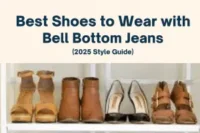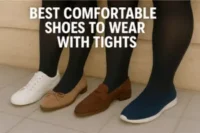E, EE, EEEE? Discover the Width Codes Brands Don’t Always Explain
Published: 6 Oct 2025
👟 Think Your Shoe Size Is Enough? Think Again.
I used to think knowing my shoe size was all I needed to get the right fit — but I was wrong, and you might be too.
Here’s the thing: shoe width matters just as much as length. That little letter next to your size — like an “E in shoe size” — can completely change how your shoes feel. If your feet ever felt cramped, squeezed, or like they were spilling over the sides, chances are you’re wearing the wrong shoe width.
This isn’t just about comfort — it’s about support, posture, and even long-term foot health. In this shoe width guide, I’ll break down what widths like E, EE, and EEEE really mean, how to measure your own foot, and how to finally find shoes that actually fit. Let’s fix this once and for all.
📏 1. What Does “E” in Shoe Size Actually Mean?
If you’ve ever looked at a shoe label and seen a letter like E, EE, or even 4E, here’s what you need to know:
- “E” stands for width, not length. It’s part of a system that tells you how wide the shoe is — super important if standard sizes feel tight.
- For men, an E shoe width usually means “wide”.
- For women, E can sometimes mean “extra wide”, depending on the brand.
- EE, EEE, and EEEE? The more E’s, the wider the shoe.
- Widths often vary by brand and region (e.g., UK vs US sizes), so one company’s “E” might feel different than another’s.
- Some brands also use terms like wide fit or extra wide fit instead of letters — but it’s the same idea.
- Understanding shoe width sizing helps you avoid discomfort, sizing guesswork, and costly returns.
📐 2. E vs EE vs EEEE – What’s the Real Difference?
It’s easy to get confused with all the E’s floating around in shoe sizes. Here’s how to decode them:
- E = Wide — usually the first step up from standard width (D for men, B for women).
- EE (or 2E) = Extra Wide — ideal for people who feel pressure around the sides or toe box in regular or E shoes.
- EEE / 3E and EEEE / 4E = Ultra Wide — for very wide feet, or for those with foot conditions like bunions or swelling.
- These widths don’t just stretch the shoe — they change the entire structure, including the sole, upper, and toe box.
- Shoe width letters can vary in actual measurements, so always check a shoe width size chart for accuracy.
- Some brands list 2E or 4E instead of repeating letters — it’s the same system.
- Need help deciding? This guide to wide width shoes makes it easier to find your match.
📏 3. How to Measure Your Foot Width at Home (No Fancy Tools Needed)
You don’t need a pro fitting to figure out your shoe width — just follow these steps:
- 🧻 Step 1: Grab a sheet of paper, a pen, and a ruler or measuring tape.
- 👣 Step 2: Place your foot flat on the paper while standing (your feet spread slightly under weight).
- 🖊️ Step 3: Trace the outline of your foot — keep the pen upright, not angled.
- 📐 Step 4: Measure across the widest part of your foot (usually the ball or just behind the toes).
- 📊 Step 5: Compare your width in mm/inches to a shoe width chart from your chosen brand.
- 🧠 Tip: Measure both feet — most people have one foot slightly wider than the other.
- 🤔 Still not sure? Check out signs like shoes feeling tight across the top or sides — clear indicators you might need wide fit or extra wide fit shoes.
↔️ 4. Shoe Width vs. Shoe Length – Don’t Mix Them Up
Think a size up will solve your tight shoes? Not always. Here’s why width and length are two totally different things:
- 🔢 Shoe size (e.g., 9, 10, 11) only tells you the length — not how wide the shoe is.
- 📏 Shoe width (e.g., E, EE, 4E) determines how much room you have across the ball of your foot and forefoot.
- 😖 Wearing a longer size to get more room? That often causes blisters, tripping, or sloppy heel fit.
- 🔄 The difference between E and EE isn’t about length — it’s about actual foot width.
- 👞 E width vs regular shoe: E shoes offer more space at the sides, not at the toe or heel.
- ✅ Getting both dimensions right = total comfort. Length handles fit, width handles feel.
- 🧠 Remember: A perfect fit means choosing both the right size and width — not compromising one for the other.
⚠️ 5. Common Signs You’re Wearing the Wrong Shoe Width
If your shoes technically “fit” but still don’t feel right, your width might be the problem. Here’s how to tell:
- 🦶 Toes feel squished or overlap — especially in the toe box.
- 🩹 Blisters or pressure points on the sides of your feet.
- 👣 Shoe bulges around the sides — a sign your foot is spilling over the sole.
- 🔄 Heel slipping — common when you size up to fix a narrow width.
- 🪡 Visible creasing or distortion in the upper material.
- 🧍♂️ Pain during standing or walking, especially on the outer edges of your feet.
- 😩 Chronic discomfort, even in new shoes marketed as “comfy.”
- 💡 If any of these sound familiar, it’s time to look into comfortable shoes for wide feet — maybe even move up to an E, EE, or EEEE width.
🛍️ 6. What Brands Offer E, EE, and EEEE Width Shoes?
Finding wide width shoes used to be a hassle — now, more brands are stepping up. Here are your best options:
- 👟 New Balance – A go-to for EE and 4E athletic shoes, especially for runners or walkers with wide feet.
- 🥿 Clarks – Offers E and EE widths in casual and dress styles, especially in the UK.
- 👞 Orthofeet – Known for orthopedic and extra wide shoes, ideal for foot conditions.
- 🩰 Vionic – Stylish options for women that don’t sacrifice comfort or fit.
- 🧤 Skechers – Many styles come in wide fit and extra wide fit options for everyday wear.
- 🇬🇧 Wider Fit Shoes UK – Specializes in E to 8E widths — great if you’re in the UK and need a broad selection.
- 👢 Propet & Hush Puppies – Great for EEE and EEEE widths in boots and casuals.
🧠 Pro Tip: Always double-check the brand’s shoe width chart — sizing can vary slightly across collections.
🌍 7. Shoe Width Conversions – US vs UK vs EU
Width sizing isn’t universal — and that’s where things get confusing. Here’s how E widths and others translate across regions:
- 🇺🇸 US System uses letters like B (narrow), D (standard), E (wide), EE/2E (extra wide), 4E (ultra wide).
- 🇬🇧 UK Shoe Widths often use letters too — but their scale is different. E is standard width for women, while F or G often means wide fit.
- 🇪🇺 European sizing focuses more on length, not width — widths are rarely marked unless it’s orthopedic or custom.
- 🔄 There’s no exact match between US “E” and UK “E” — don’t assume they’re the same.
- 📊 Always consult a shoe width chart UK vs US before ordering across borders.
- 🛒 Some brands include a width letter + a number (like “9EE”) while others just say “Wide Fit.”
- 🧠 When shopping internationally, filter by wide fit, extra wide, or check brand-specific width guides.
🦶 8. When Should You Consider Extra Wide Shoes?
Not sure if you actually need extra wide shoes? Here are clear signs and situations when they’re more than just helpful — they’re necessary:
- 👣 You have wide feet by measurement — check using a foot width chart or measure at home.
- 🩼 Medical conditions like bunions, hammertoes, or plantar fasciitis make standard widths painful.
- 💉 Diabetes or neuropathy requires more room to avoid pressure points and skin damage.
- 🦵 Swelling (edema) in feet or ankles — especially common during travel, long work shifts, or pregnancy.
- 👵 Aging feet naturally spread over time — your width needs may change even if length stays the same.
- 🧬 Wide feet can be genetic — if your parents wore EE or 4E, you likely need them too.
- 🛌 If shoes feel better at the end of the day when your feet swell, you probably need a wider fit.
- 💡 Investing in the best shoes for wide feet isn’t about luxury — it’s about long-term foot health and preventing injury.
👠 9. Do Wide Shoes Look Ugly or Bulky? (Spoiler: Nope.)
Let’s be real — one big reason people avoid wide shoes is style fear. But that’s outdated thinking. Here’s the truth:
- 🧵 Modern wide fit shoes are stylish by design, not just wider versions of ugly orthopedics.
- 🧢 Brands like Vionic, Clarks, and New Balance now blend comfort + fashion in wide styles.
- 👠 You can find heels, boots, sneakers, and flats — all in E, EE, even 4E widths — that look great.
- 🧍♀️ Wide shoes today come with better structure and sleeker profiles — no more boxy shapes.
- 🛍️ Want fashionable wide width shoes? Look for brands that list widths upfront or offer wide fit collections.
- 🔄 Tip: Always compare wide fit vs extra wide fit styles — the right width gives you a sleeker fit without the bulge.
- ✨ No one will notice your width — they’ll notice your style and how confidently you walk.
⏳ 10. The Truth About Break-In Time for Wide Shoes
Think all shoes need a painful break-in period? Not if you’re wearing the right width. Here’s what to know:
- 👣 Wide shoes (like E or EE widths) should feel comfortable from the first wear — no pinching, no squeezing.
- ❌ If you’re “breaking in” pain, it’s likely the wrong size or wrong width — not just stiff material.
- 🧠 Many people think discomfort = normal — especially in dress shoes. It’s not.
- 💡 Extra wide shoes (4E and up) may feel roomy at first, but they shouldn’t be sloppy or loose.
- 🧦 Try them with the socks you actually plan to wear — thin socks = tighter feel, thick = looser fit.
- 📦 If a shoe still hurts after 2–3 wears indoors, return it — you deserve comfortable shoes for wide feet without compromise.
- 🛠️ Break-in tricks (like shoe stretchers) work only if the width is close — they can’t fix major fit issues.
✅ 11. Conclusion & Key Takeaways — Don’t Settle for a Tight Fit
You’ve learned a lot — and your feet will thank you for it. Here’s what to remember:
- 👟 Shoe width matters as much as length — don’t ignore it.
- 🔠 E in shoe size means wide — and more E’s = more width (EE, EEEE, etc.).
- 📏 Measure your foot length and width at home to get your true fit.
- 🗺️ Width sizing varies across brands and regions (US, UK, EU) — always check the chart.
- ⚠️ Common signs of wrong width: pinching, bulging, heel slip, or constant discomfort.
- 🩺 Extra wide shoes aren’t just for medical needs — they’re for comfort, confidence, and support.
- 💃 Wide shoes can be stylish, modern, and flattering — no more clunky designs.
- 🛍️ Take your time. Use this guide. Choose shoes based on both size and width — not just what’s on the box.
👣 Final tip: Your feet support everything you do. Make sure your shoes support them back.
🧠 Still Confused About E, EE, and Widths? These FAQs Clear It Up
If your shoes feel tight on the sides but the length fits fine, you likely need a wider width, not a longer size. Sizing up often leads to heel slip and poor support. Always measure both your length and width to get the right fit.
2E (or EE) means extra wide in most sizing systems, especially in men’s shoes. It offers more space across the forefoot and midfoot compared to a standard or E width. If regular shoes feel snug, this may be your ideal fit.
Not at all. Wide shoes are for anyone whose feet are naturally broader, or who wants better comfort and fit. They’re also great for preventing issues like bunions, blisters, and foot fatigue.
Not anymore. Many brands now make fashionable wide width shoes that look just like regular styles — just with a more forgiving fit. You can find trendy sneakers, heels, boots, and more in E or EE widths.
You can stretch shoes a little using tools or a professional, but it won’t fix major width issues. If your feet are consistently cramped, it’s better to switch to the right E, EE, or 4E width from the start. Proper fit = long-term comfort.

- Be Respectful
- Stay Relevant
- Stay Positive
- True Feedback
- Encourage Discussion
- Avoid Spamming
- No Fake News
- Don't Copy-Paste
- No Personal Attacks



- Be Respectful
- Stay Relevant
- Stay Positive
- True Feedback
- Encourage Discussion
- Avoid Spamming
- No Fake News
- Don't Copy-Paste
- No Personal Attacks





